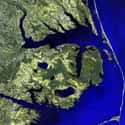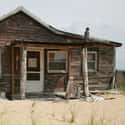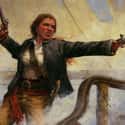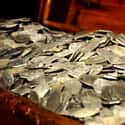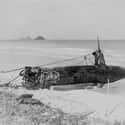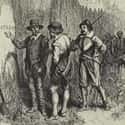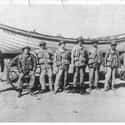-
(#1) When It Comes To Nautical Terrors, Geography Is Everything
Just look at any map of North Carolina's Outer Banks. It can't help itself. A long, narrow strand of small islands stretches out into the Atlantic and curves around, hugging the North Carolina coast. Even the breakwater between the string of isles and the mainland area of the coast is replete with hidden coves and lagoons, perfect places for skulking pirates and other watery criminals.
The entire region has served as a wrecking magnet for watercraft, from the earliest years of European exploration right through WWII, and to this day, boaters and sailors cannot fully count on even the most modern RADAR and SONAR to protect them from the dangerous Graveyard of the Atlantic.
It's the storms - some coming from as far north as New England - that push vessels off course and sweep them down to the Outer Banks, where they are beaten by waves, or scuttled onto rocks, sometimes leaving survivors, but often times not.
-
(#2) A Beautiful Socialite Mysteriously Disappeared At Sea
Was a beautiful and wealthy 19th-century socialite a victim of the Graveyard of the Atlantic? Perhaps.
Theodosia Burr Alton's life and mysterious death are the stuff of legends. Born into a privileged world as the daughter of the third US Vice President, Aaron Burr, Theodosia was beautiful, educated, and by the time of her disappearance, a woman overcome with personal grief. While still a teenager, her famous father encouraged her to marry a wealthy South Carolinian, Joseph Alston, who would one day become governor of that state. The couple lived on Alston's large plantation. The isolation and humid Southern weather had little appeal to Theodosia, but she loved her husband, his family, and especially their only son and child, Aaron Burr Alston.
Then her life changed from one of boredom and dissatisfaction to one of grief and humiliation. As the only child of Aaron Burr, Theodosia was shocked and embarrassed by the duel in which her father shot and killed Alexander Hamilton. Then her child died suddenly, as well.
Grief-stricken, she made plans for a long visit to New York, where she would be among family and old friends. Her husband and her father both counseled her against the trip: after all, the War of 1812 was raging and the American coast was unsafe as a result. Always a strong and independent woman, Theodosia went ahead with her plans. Her husband made sure the small ship that transported his wife was sound, and the captain and crew sober. Several other passengers accompanied Theodosia on her journey. On New Year's Eve 1812, she boarded the schooner Patriot and headed north.
Neither she nor the ship were ever seen or heard from again.
Unless....unless one counts the fine oil portrait of Theodosia that mysteriously showed up in a poor man's home on the Outer Banks, later in the 19th century, as evidence.
There are many legends and even ghost stories concerning Theodosia's demise, but only one has ever presented actual evidence connecting the young woman with the Outer Banks.
In the mid-1800s, a doctor was summoned to an old beach shack at Nags Head, on the Outer Banks. It was owned by a poor man, whose elderly mother was ill. A number of poor people lived along the chain of tiny North Carolinian islands, among them some who made their living scavenging wrecked and scuttled vessels just off shore.
The old woman, Molly Mancarring, and her son had no money to pay the doctor, but offered him a high-quality oil portrait of a lovely young woman. The doctor accepted the painting as payment, and noted that other luxurious items were in the possession of the poor family, including early 19th-century silk dresses. All of these were items were far beyond the family's means.
The doctor asked where in the world the family had acquired the painting. Molly responded that when she was a newly married young woman in 1812, her husband (who was a "wrecker") had found the portrait, the dresses, and other items on a scuttled ship.
The portrait now hangs in the Walpole Library at Yale University. It has never been positively identified with Theodosia Burr Alton, but the existence of the portrait, the place, the timing, and the resemblance to known portraits of the young woman make this story among the more plausible legends surrounding the lost woman, who many think was attacked by pirates.
Whatever became of her, it is likely that at some point between South Carolina and New York, Theodosia came to her end somewhere in the Graveyard of the Atlantic.
-
(#3) Blackbeard's Graveyard Hideout Became His Final Resting Place
Everyone has heard of Blackbeard the pirate. He was a real person called Edward Teach. He actually lived on one of the islands along the Graveyard of the Atlantic. The site was perfect, what with its endless, hidden coves, lagoons, and inlets. A pirate could slip in and out of the area swiftly, particularly when there was a need to hide. He was born and grew up in Bristol, England, and at first went to work as a "legal" pirate - or as the English government then called it, a "privateer." He soon, however, realized that he could make much more money as an illegal privateer; or, pirate. He crewed on several ships before obtaining his own, which he named the Queen Anne's Revenge.
The Carolinas were somewhat accustomed to the proliferation of piracy on their shores, and for some time the activities of Blackbeard and other pirates were tolerated. He even maintained a home on shore, along the Outer Banks, taking breaks before venturing out again to wreak and plunder. One of his favorite pastimes was to attack any passing merchant ship, relieve it of its goods, and then sell the goods to townsfolk along the Outer Banks. This helped to stimulate the local economy, which is probably why the local officials turned a blind eye to it. It was a good life.
But, in 1718, Blackbeard went too far. He kidnapped several South Carolina government officials and held them for ransom. Once he received payment, he let the men go, but this set government leaders astir across several states. Enough was enough for Blackbeard and his ilk.
But the Carolinas, even working together to rid themselves of the piratical scourge, were not powerful enough. So, they asked Virginia's powerful governor, Alexander Spotswood, to help. He was eager to do so, as he despised all pirates. A colonial Navy was organized under Virginia leadership, and it sailed to the Outer Banks in short order. Blackbeard, who was utterly comfortable cruising along the Carolina coast, was caught completely off guard. A battle ensued, with losses sustained on both sides.
Blackbeard did not go down without a bitter fight. Before he finally collapsed on the deck of his ship, he had received more than 25 wounds, five of which were from gun shots. The victorious colonial forces cut off Blackbeard's head and hung it upon the foremast of a warship.
-
(#4) "Bankers" Were Infamous For Scavenging Shipwrecks
"Bankers" is the term given to the people who lived along the edge of the Graveyard of the Atlantic for hundreds of years. These days, the strand is dotted with numerous, often luxurious vacation homes, hotels, and condos. But for the first 300 years of Outer Bank settlement, the region held no interest for the wealthy or the vacationing tourist. Property values were low, and the barrier islands could boast only of worn out, often broken down shacks. Not much could withstand the regular storms and fierce winds that roared up and down the coast. Most of the inhabitants lived there because they had nowhere else to go. Property values were low and poverty was common.
Except - sometimes this was not the case. There was one employment along the Banks that was often quite profitable, albeit at least somewhat illegal. It involved salvage. Bankers were notorious for watching boats and ships founder and wreck, then retrieving and claiming whatever washed up or what they could scrounge from the wreck. Now, salvage law is a little murky, then and even today. It is difficult to prove outright theft when items - however valuable - wash to shore or are abandoned in the shallows. Bankers regularly collected useful and valuable items for their homes, or to sell. Some items included furniture, expensive cloth, barrels of wine and spirits, luxurious clothing, artwork, and decorative objects.
Even if the Bankers took the items they found legally, they and their neighborhoods were looked down upon. Indeed, they were often referred to as "land pirates."
-
(#5) Lady Pirates Ravaged The Outer Banks
Well, of course some pirates were female! Some of the boldest and bravest among them. And yes, some of them considered the Graveyard of the Atlantic among their favorite hideouts.
Two of the more famous women who took to pirating, and are associated with the Graveyard of the Atlantic, were Anne Bonny and Mary Read. Anne grew up tough, but her father still had standards. So, when she was 16 and brought home the young, aspiring pirate James Bonny, her father said, ditch him or get out of my house. So she left with her lover, whom she fully supported in his career. He was a rather small-time pirate, but she felt he had potential.
She was soon let down, especially when she found out that her pirate husband was now working for the government to stop piracy. Essentially, he was doing undercover spy work for the colonial government. While some women might consider that a step up in the world, Anne Bonny did not. She wanted a wild, pirate husband.
So she took up with the somewhat more famous "Calico Jack" Rackham. He got his nickname from the colorful clothing he wore. (Every pirate sought an image, or, brand, if you will.) Calico Jack was in love with Anne and even offered to buy her from her husband. But James Bonny was not only unwilling to sell his wife, he would not even grant her a divorce. By now Anne was pregnant with Jack's baby, so the two left and went to Cuba until the baby was born. While she was there, Anne met Mary Read, who shared her views and interest in the world of piracy. When Jack returned to pick up his lover and their baby, Mary came along, and both women joined Jack's crew. Some suspect that Anne and Mary were lovers as well as friends. Whatever the situation, they remained close and fought together during battles on Calico Jack's ship, the Revenge.
Both women were bold and fearsome fighters. When the Revenge was finally cornered by the British Navy, every man on board was drunk. A legend surrounding the brief battle claims that all the men ran scared below deck, while the two women led the fight. It was a losing battle, though. Jack and his entire crew were arrested and tried. Only Mary and Anne escaped the noose. Both "plead their belly" (claimed pregnancy) to avoid execution.
-
(#6) The Treasure Of El Salvador Is Still Lying Somewhere In The Graveyard
Yes, the legends and stories of Spanish gold lost in the Graveyard of the Atlantic are true. One of the most famous of these concerns a Spanish treasure fleet that was lost in the Outer Banks in 1770. It was called the El Salvador, and was among six ships loaded down with gold and silver from the New World.
One might wonder how and why did a fleet of Spanish ships wind up wrecked along the Outer Banks? Once again, the answer lies in geography -and the Gulf Stream. All six ships were sailing from Central America and up to the coast of Florida, where they headed out into the Atlantic. Unfortunately, they ran right into the northerly Gulf Stream, which pulled them off course, racing up the Eastern seaboard until North Carolina's infamous geography kicked in and dashed the ships onto rocks and into the shallows of the Graveyard of the Atlantic.
Some of the ships limped to shore and their cargoes were saved. Those that wrecked in shallow water were also somewhat spared, with surviving crew rescuing the precious cargo and hauling it to other waiting ships. But the El Salvador was never found. And to this day, treasure hunters are still looking for it. The cargo would be worth many millions of dollars today.
-
(#7) Banker Horses Were Shipwrecked Living Cargo That Now Run Free On The Coast
Some of the many European ships to founder and sink into the Graveyard of the Atlantic carried living cargo, including goats, chickens, and especially, horses. The Spanish were the first Europeans to reach the New World and were extremely active along the American Atlantic coast during the 16th and 17th centuries. Throughout those years, Spanish ponies and horses were shipwrecked along with their human companions, and survivors were left to wander the lonely shores of the Outer Banks. Additionally, some horses arriving under circumstances other than shipwrecks were sold or traded to tribal people living along the North Carolina coast.
The Outer Banks was almost entirely wilderness across the 157 miles they extended along the coast. This was one important reason for the horse's survival. As herd animals, the horses quickly recovered from their terrors at sea and formed strongly-bonded herds, which grew via reproduction and new arrivals as more shipwrecks succumbed to the Graveyard. Additionally, the long-term isolation of the region essentially granted the herds their own equine kingdom. They became known as "Banker horses," and over the next three centuries observers recorded the success of the herds.
For example, in the early 18th century, English historian John Lawson visited and explored southeastern North Carolina for years. He reported that although they were wild, the "horses are well-shaped and swift. The best of them would sell for ten or twelve pounds in England... and will travel incredible journeys." He also recorded that the wild Banker horses were overall fine specimens of health and were well-treated by local tribes.
Later, 19th-century historian Edmund Ruffin, who was also an authority on agriculture, recorded that a popular corralling and branding of the horses and colts was held twice a year on the Outer Banks. He also reported that though the horses had shaggy, ungroomed coats and rough hooves, they were otherwise healthy. He added that most of the local farmers' horses at the time were tamed Banker horses.
The wild horses of the Outer Banks continue to thrive today. In the late 1980s, several organizations were formed with the aim of conserving the animals. After having survived and thrived for 500 years, it was time for human protection and recognition.
In 2007, inspectors from the Horse of the Americas Registry (HOA) arrived in the Outer Banks community of Corolla, where they examined the wild herd to determine if they were authentically descendants of the old Spanish Mustangs that escaped shipwrecks on the shore. The results of the examinations were positive, and since then the Banker horses have nationally-recognized protection.
-
(#8) An Unlucky Gentleman Pirate Sailed His Ship "The Revenge" In The Graveyard
Blackbeard the pirate was only the most notorious among many people engaged in the scandalous trade amid the Graveyard of the Atlantic. Another pirate, nearly as famous as Blackbeard, was Stede Bonnet, better known as the "Gentleman Pirate." Hailing originally from Barbadoes, Bonnet came from a wealthy Caribbean planter's family. He was born to money, but apparently wanted money of his own and acquired it in the most adventurous way possible.
He built a ship called The Revenge, and one night he sailed north to the Carolinas, where he began his career of pillaging and looting. On one particularly memorable occasion, he ran into a Spanish warship, with whom he foolishly engaged and wound up losing half of his crew. He managed to escape with his ship and swiftly sailed to the Bahamas, where he had the bad fortune to run into Blackbeard, who took advantage of Bonnet's inexperience, and also his ship, eventually leaving Bonnet stranded in South Carolina.
Bonnet managed to reach Blackbeard's hometown of Bath, North Carolina, where he was somehow able to secure a pardon from the state governor, promising never to return to piracy. He lied, returning to his chosen profession at the first opportunity. However, he was captured in 1718, when piracy was no longer so fashionable in the Carolinas, and was tried, convicted, and hanged.
-
(#9) In WWII, The Graveyard Was Known As "Torpedo Alley"
The Graveyard of the Atlantic does not confine itself to preying upon pirate and sailing ships from long-ago centuries. The Graveyard was greedily accepting new victims well into the 20th century.
For example, a number of both Allied shipping vessels and German U Boats met their untimely doom in the shallow shoals of the Outer Banks. Nearly 400 of these were sunk during the war, which earned the area a new nickname: "Torpedo Alley." The attacks began in January of 1942 and over the next few years, more than 5,000 lost their lives as a result.
One of the most infamous episodes during the period had to do with the German submarine U-85. It was the first of three of its kind that were torpedoed in 1942, just off the shores of Bodie Island Lighthouse. The German vessel was actually headed home, away from the American coast, when the American destroyer USS Roper noticed its presence on the radar. A battle ensued, ending when the American vessel dropped 11 depth chargers over the German boat, resulting in its sinking and the deaths of all aboard. Twenty-nine bodies washed ashore and were given burials.
What makes this story particularly intriguing is that some of the Germans recovered were wearing civilian clothing and carrying wallets with American identification and currency. There is a legend in Norfolk, Virginia, told by older residents who remember hearing about German sailors coming ashore as tourists, even going to movie theaters and restaurants. No one will ever know for sure, but it's just possible that some of the men aboard U-85 spent their final days as tourists in Virginia.
-
(#10) The Lost Roanoke Colony Disappeared In The Graveyard
Lots of people have heard the legend of Roanoke Island's Lost Colony. But not everyone realizes that it was located right in the midst of what would become known as the Graveyard of the Atlantic. In fact, it is not unusual for visitors to the city of Roanoke, which is located in southwest Virginia, to assume they have arrived at the famous Lost Colony.
However, the Roanoke colony was actually located in the Outer Banks of North Carolina. In 1587, a group of 115 English colonists landed on Roanoke Island, just off the coast, and established a successful settlement. Their leader, John White, returned to England for supplies but he was delayed, and when he returned three years later, he found the entire colony had simply disappeared.
While no shipwrecks were reported during that brief period of English colonization, it remains a great mystery and tragedy in American history. Later arrivals, beginning with John Smith at Jamestown, were charged with inquiring as to the fate of the Roanoke colonists.
Theories have abounded over the 400 years that have passed since their disappearance. One of the more plausible ones has to do with the Roanoke colonists packing up and moving to what is now Hatteras Island, at the southern tip of the Outer Banks. It was true that their friend and tribal guide, Manteo, was from the southern Banks, though at that time his island was called "Croatoan" - which coincidentally was the word carved into the palisade of Roanoke Fort and discovered by John White when he got back to his vanished colony. Eighteenth-century visitors to Croatoan/Hatteras noted that they had met tribal people there who wore European clothing, had fair hair and gray eyes. They spoke of having ancestors who could "talk in a book" (read).
Today, the search for the Lost Colony continues, with ever more intriguing theories and suppositions. There is even an effort to locate the missing English families via DNA studies of people living in the Hatteras region today.
-
(#11) The Graveyard's Last Great Sailing Ship Victim Was Torn Apart For Scrap During WWII
The last known sailing ship to wreck in the Graveyard of the Atlantic was the G.A. Kohler. It was a large, four-masted schooner that became caught in the famous storm of 1933. The ship ran aground and was mostly beaten to death by the waves from the storm. The remains of the ship sat abandoned and neglected on the beach for ten years.
When WWII began, citizens were scrambling for any type of iron scrap to donate to the war cause. Suddenly someone remembered the poor old G.A. Kohler and she was shortly stripped of all her metal fittings, including iron. Then she was burned right there on the beach. Depending on shifting sands, visitors to the Outer Banks can still sometimes see what remains of the ship, located at Ramp #27, near the town of Salvo.
-
(#12) The Ghost Of A Murdered Surfman Is Said To Haunt The Coast
Nineteenth- and twentieth-century coastal surfmen were the unsung heroes and sometimes saviors at the Graveyard of the Atlantic. The young men lived much like firemen of today, in rescue stations, waiting for the call to rescue ships, boats, and people that were in the grip of the Graveyard. The Outer Banks had seven lifesaving stations at one time, scattered all along the 157-mile strand of islands.
The life of a surfman was a hard one, especially on the days and nights when a rescue was involved. Not a few of the young men perished while on duty. And, of course, not all the men hired to do the job were very good at it, or mature enough to take on such grave responsibility.
Such was the case with young T.L. Daniels, who was working as a surfman at Station Six in 1884. Today we would say that the young man had an "attitude," and struggled with taking orders from those of higher rank. In this case, the higher ranking individual was Captain James Hobbs, and he was a man who demanded obedience and did not suffer fools. Station Six was not known for being a place of discontent, but over time, the young surfman and his boss created an uncomfortable tension between themselves; and thus, the rest of the surfmen. They argued loud and long and frequently. On one occasion, Daniels began to insult Hobbs's wife and the latter decided he had had about enough from the surly young surfman. Hobbs pulled his revolver and shot Daniels dead right in front of the other young men.
Hobbs then directed the remaining surfmen to clean up the mess. It was decided that Daniel's body would be taken out in a boat and buried at sea. And so the Graveyard took yet another victim.
As for Hobbs? He walked. There were no police or other authorities nearby, so the entire crime was completely covered up, and Hobbs was cleared of any wrongdoing.
Those into visiting scenes of true crime might want to visit the Black Pelican Restaurant, which incorporated the old Station Six Lifesaving Station into its present location. Apparently, Daniel's ghost regularly haunts the site.
New Random Displays Display All By Ranking
About This Tool
In the North Atlantic Ocean, there is a mysterious sea area called "Graveyard Of Atlantic". This area is located near important routes between the United States and Canada. Over the past few hundred years, more than 500 large and small ships have mysteriously sunk near this area. The peculiar geographic location and ocean currents have caused various nautical disasters.
Many navigators are afraid of this sea area, and there are many weird and mysterious legends and tales about "Graveyard Of Atlantic", it seems to be controlled by the god of death. The random tool shares 12 interesting tales of Macabre who were from "Graveyard Of Atlantic".
Our data comes from Ranker, If you want to participate in the ranking of items displayed on this page, please click here.











